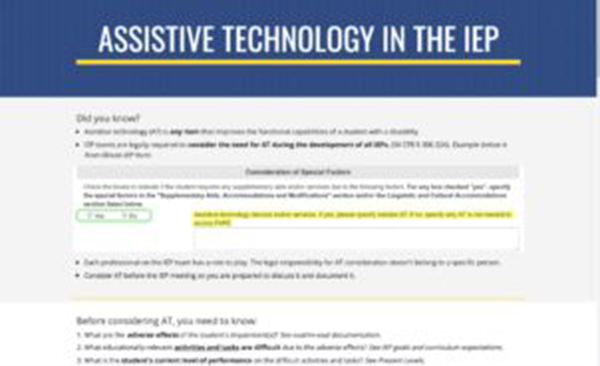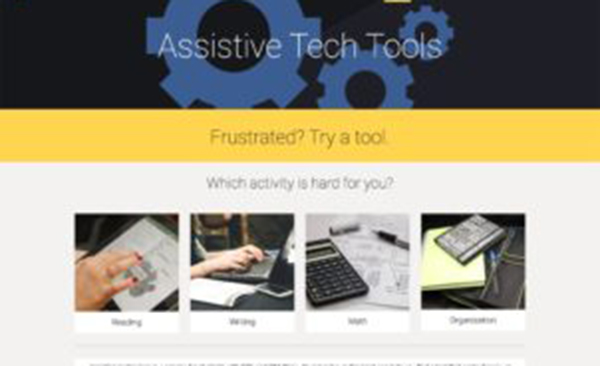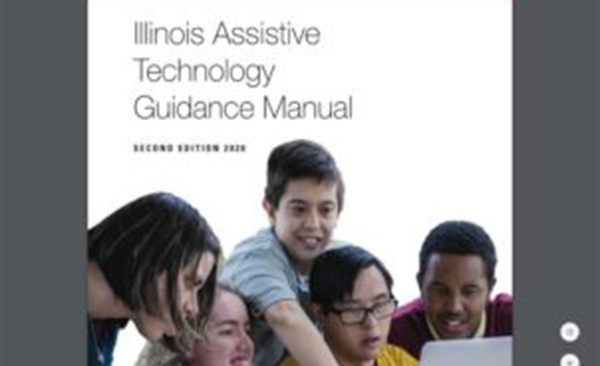AT Services for School-Aged Children
Children in public schools ages 3 to 22
Public schools are an important funding source for assistive technology devices and services for children with disabilities. The UIC Assistive Technology Unit (ATU) works with schools to collaboratively support your child’s team in the consideration, assessment and implementation of assistive technology (AT).
Quote
For students to use AT effectively, it is essential to understand AT use as a process, not just a set of tools … School systems need to ensure that those who work with students have the knowledge and skills necessary to engage in these processes and establish infrastructure to support them.
| Illinois AT Guidance Manual, 2nd Edition
Which students are eligible?
Students with Individualized Education Programs
The Individuals with Disabilities Education Act (IDEA) requires public school districts to consider AT devices and services for every student with an Individualized Education Program (IEP). The student’s IEP team, which includes the parents, is responsible for making decisions related to the need for both AT devices and services.
AT devices includes “any item” used to “increase, maintainm or improve the functional capabilities of a child with a disability” and only excludes surgically implanted medical devices (C.F.R. 34 § 300.5).
AT services include “any service that directly assists a child with a disability in the selection, acquisition, or use of an assistive technology device.” This includes “the evaluation of the needs of a child with a disability, including a functional evaluation of the child in the child’s customary environment” (C.F.R. 34 § 300.6).
Students with 504 plans
Section 504 of the Rehabilitation Act of 1973 ensures that students with disabilities have an equal opportunity to participate in school activities. AT can be considered as an accommodation for students with 504 Plans.
Students in private and parochial schools
Private and parochial schools, including homeschools, are not required to provide AT devices or services. However, the public school district within which the student lives must provide “child find” services, which might include a special education evaluation to determine eligibility. An AT evaluation could be included as part of the special education evaluation when determined necessary by the team.
What we can do for you
We work with your child’s school team to support the consideration, assessment, and implementation of assistive technology.
A variety of AT specialists are available, depending on the student’s need. The ATU is an interdisciplinary team of RESNA-certified AT specialists with professional backgrounds in special education, occupational therapy, physical therapy, speech-language pathology and rehabilitation engineering.
Service options
- Initial phone inquiry to determine services (free)
- Consultation options (team meeting):
- Training on AT problem-solving process for the team, including parents
- AT consideration process with school team, including parents
- Collaborative service options (with student):
- Collaborative AT evaluation
- Collaborative AT implementation
- Collaborative AT follow-up
- Clinical evaluation (for students close to exit at graduation or age 22)
Collaboration and problem-solving

Team-based collaboration
AT for school-aged children requires a collaborative decision-making process. AT is considered alongside other types of accommodations and interventions.
- For school-age children attending public school, ATU services are provided in collaboration with the child’s IEP or 504 team, including parents and the student.
- For school-aged children in private and parochial schools, including homeschools, ATU services are provided in collaboration with the family and/or the child-find services of the local public school district.
Integrating AT into the problem-solving process
For school-based services, the ATU uses an AT process model that integrates the Johns Hopkins University (JHU) AT Cycle with the basic problem-solving process. AT collaborations are offered along any point of the problem-solving cycle in collaboration with the school team.
Integrating AT into the Problem-Solving Process: An AT Process Framework for Schools. January 2020, Copyright Daniel Cochrane, MA, MS, ATP.
- Problem Identification and Analysis (What’s the problem and why is it occurring?)
- Identifying difficult activities or tasks
- Analyzing task-demands
- Gathering or identifying the need for specific performance data
- Plan Development (What are we going to do about it?)
- Consider AT
- Identifying difficult task-demands
- Matching AT features to difficult task-demands
- Choose & Trial AT
- Choosing specific products
- Designing pre/post test-drives of specific products
- Implementing AT
- Providing AT competency training (operational, functional, strategic, social)
- Creating AT implementation plans
- Brainstorming AT implementation strategies
- Consider AT
- Progress Monitoring (Is it working?)
- Designing AT progress monitoring tools
- Brainstorming AT integration strategies
Links
Services for students transitioning out of school-based services

Students exiting the K-12 public school system at 18 years (high school graduation) or 22 years (end of transition services) may need an alternative funding source for AT. School-owned equipment will not follow the student to post-secondary or employment settings.
The primary options for alternative funding are:
- Health insurance for items considered medical devices (e.g. wheelchairs, communication devices)
- State funding (e.g. vocational rehabilitation)
- Self-funding
These funding sources may require a formal AT evaluation report from a licensed professional that addresses the post-secondary environment and specific eligibility criteria. The ATU is able to provide clinical evaluations for some types of AT.
The ATU is able to provide vocational rehabilitation-funded clinical evaluations but the referral must come through the DRS-VR system.
Team collaboration vs. clinical evaluation
The type of service recommended depends on the funding source and the student’s age.
- School-funded AT requires a collaborative approach
- Insurance- or state-funded AT may require a clinical evaluation before the student exits the K-12 school system. However, a collaborative approach would still be used for PK-11 grade students because implementation of AT will occur in the school setting.
The type of service will be determined in collaboration with you.


